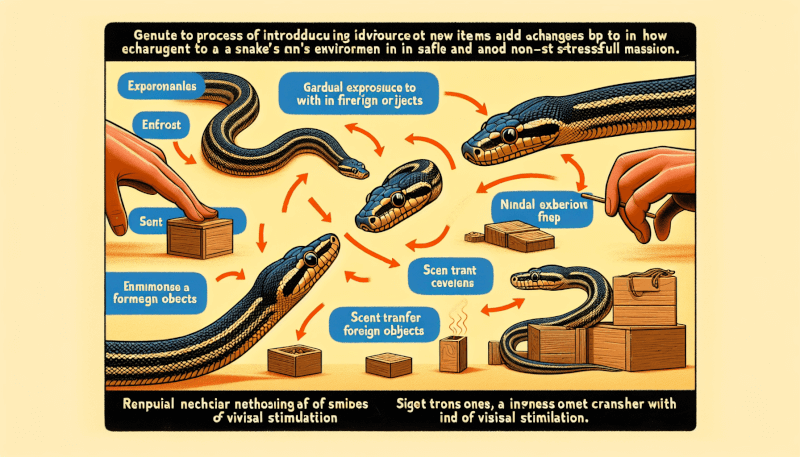You love your snake and want to provide the best possible environment for it. But how do you safely introduce new items and changes to its habitat without causing stress or discomfort? In this article, we will explore some tried and true methods to help you navigate this process smoothly. From choosing the right timing to gradually introducing new elements, we will discuss the best ways to ensure a seamless transition for your slithery friend. So, let’s dive in and discover how you can make your snake’s environment a safe and happy haven.

Choosing the Right Items
When it comes to introducing new items to your snake’s environment, it’s essential to choose the right ones. This involves conducting thorough research before making any purchases. Take the time to familiarize yourself with the different types of items available for snakes, such as hides, decorations, and toys. Look for reputable brands that offer high-quality products specifically designed for snakes.
In addition to researching the items themselves, it’s important to consider your snake’s natural habitat. Snakes come from a variety of environments, ranging from tropical rainforests to desert regions. Understanding the specific needs of your snake’s species can help you select items that closely mimic its natural surroundings. For example, if your snake is known for spending most of its time hidden in dense foliage, providing ample hiding places with leafy decorations would be ideal.
Once you have a good understanding of the items your snake needs, you can select appropriate materials. Snakes have sensitive skin and can be easily injured by rough or sharp objects. It’s best to choose items made of smooth materials, such as silicone or resin, that won’t cause any harm to your snake. Avoid items with small parts that your snake could swallow or get stuck in.
Gradual Introduction
When introducing new items to your snake’s environment, it’s important to proceed gradually. Snakes can be sensitive to changes in their surroundings, and sudden introductions may cause stress or anxiety. To avoid overwhelming your snake, allow for acclimation by introducing one item at a time.
Start by adding the new item to your snake’s enclosure and observe its behavior for a few days. If the snake seems comfortable and shows no signs of stress, you can slowly introduce another item. This gradual approach allows your snake to adjust to each new addition at its own pace.
Throughout the introduction process, closely monitor your snake’s behavior. Look for any signs of distress, such as excessive hiding, loss of appetite, or unusual aggression. If you notice any concerning behaviors, it may be a sign that your snake is not comfortable with the new item. In such cases, removing the item and seeking professional advice is recommended.

Handling Techniques
Handling your snake can be a rewarding experience, but it’s important to approach it with caution and respect for the snake’s needs. Using gloves or tongs can provide an added layer of safety for both you and your snake. These tools allow you to handle your snake without direct contact, reducing the risk of accidental bites or injuries.
When handling unfamiliar objects, such as new decorations or toys, it’s crucial to exercise caution. Snakes are curious creatures and may investigate new items by tasting or biting them. Avoid allowing your snake to have direct contact with unknown objects until you are confident that they pose no harm.
Understanding your snake’s temperament is also essential for safe handling. Some snakes are naturally more docile and tolerant of handling, while others may be more skittish or defensive. Take the time to observe and learn about your snake’s behavior to ensure you handle it in a way that suits its personality.
Scent Transfer
Scent transfer is a technique that can help your snake become more comfortable with new items. By transferring the snake’s scent onto the item, you can make it more familiar and reduce any potential stress associated with its introduction.
One method of scent transfer is rubbing the items with your snake’s shed skin. Snakes shed their skin regularly, and the scent left behind on the shed skin can be a reassuring presence for them. Rubbing the new items with the shed skin can help create a familiar scent that your snake will find comforting.
Another technique is to place the new items in your snake’s hide. The hide is a safe space that your snake uses for resting and feeling secure. By incorporating the new items into this space, you are associating them with a familiar and comforting environment. This can help your snake accept the items more readily.

Cleaning and Disinfecting
Maintaining a clean and hygienic environment is crucial for the health and well-being of your snake. However, it’s essential to choose snake-safe cleaning solutions to avoid any harm to your pet. Harsh chemicals should be avoided, as they can be toxic to snakes and cause respiratory or skin irritations.
Instead, opt for specialized reptile-safe cleaning solutions that are designed to effectively clean snake enclosures while being safe for the snake. These products are formulated to remove bacteria and odors without posing any risk to your snake’s health.
Regular cleaning and disinfection should be a part of your routine maintenance. This helps prevent the buildup of bacteria or parasites that could be harmful to your snake. Establish a cleaning schedule that works for you and ensures that your snake’s enclosure remains clean and hygienic at all times.
Providing Hiding Places
Hiding places are essential for snakes as they provide a sense of security and allow them to retreat and rest when they feel stressed or threatened. Providing multiple hideouts throughout your snake’s enclosure is important to ensure that it has plenty of options to choose from.
To create a sense of security, consider placing the hides in different areas of the enclosure. This allows your snake to choose the hideout that suits its mood or temperature preference. Some snakes prefer a cooler hiding spot, while others may prefer a warmer one. By providing options, you allow your snake to regulate its body temperature and feel more comfortable in its environment.
The hides themselves should be suitably sized for your snake. Snakes prefer snug spaces that make them feel secure, so choose hides that are just large enough for your snake to fit inside comfortably. Avoid providing hides that are too spacious, as this may make your snake feel exposed and vulnerable.

Temperature and Humidity Considerations
Temperature and humidity are critical factors in creating a suitable environment for your snake. Snakes are ectothermic animals, meaning they rely on external sources of heat to regulate their body temperature. Ensuring proper heat levels is essential for their overall health and well-being.
Monitor the temperature in your snake’s enclosure using a thermometer to ensure that it stays within the recommended range for your snake’s species. Provide a temperature gradient by placing heat sources, such as heating mats or lamps, at one end of the enclosure. This allows your snake to move between warmer and cooler areas, mimicking the natural conditions it would experience in the wild.
Humidity levels are also important, as they can affect your snake’s respiratory health and the shedding process. Different snake species have varying humidity requirements, so it’s crucial to research your snake’s specific needs. Use a hygrometer to monitor the humidity levels and make any necessary adjustments by adding a water dish or misting the enclosure.
Avoid sudden changes in temperature or humidity, as this can stress your snake. Gradual adjustments are key to maintaining a stable environment that promotes your snake’s health and comfort.
Observing the Snake’s Behavior
As a responsible snake keeper, it’s crucial to observe and understand your snake’s behavior. Snakes can’t communicate verbally, so it’s essential to pay attention to their body language and habits. By noticing signs of stress or discomfort, you can address any issues promptly and make adjustments as needed.
Signs of stress in snakes can include excessive hiding, decreased appetite, sudden aggression, frequent pacing, or repetitive movements. If you notice any of these behaviors, it may indicate that there is a problem with your snake’s environment or that it is experiencing health issues. In such cases, take the time to evaluate the situation and make any necessary changes.
Adjusting accordingly involves modifying the factors that could be contributing to your snake’s stress. This could include rearranging the furniture in the enclosure, adjusting temperature or humidity levels, or removing any items that seem to be causing distress. Always prioritize your snake’s well-being and take action to address any concerns promptly.
If you’re unsure about how to interpret your snake’s behavior or if you have any concerns, it’s always a good idea to seek advice from a herpetologist or an experienced snake keeper. These experts can provide valuable insights and guidance tailored to your specific snake species. Don’t hesitate to reach out and ask for help when needed.

Consulting an Expert
Sometimes, despite your best efforts, you may still have questions or concerns about introducing new items and changes to your snake’s environment. In such cases, it’s always a good idea to consult an expert.
A herpetologist or an experienced snake keeper can provide valuable advice and recommendations tailored to your specific snake. They have extensive knowledge and experience working with snakes, and their insights can help you make informed decisions about your snake’s habitat and well-being.
Whether you need guidance on selecting the right items, addressing behavior concerns, or maintaining a healthy routine, consulting an expert can provide the support and reassurance you need.
Maintaining a Consistent Routine
Snakes thrive on routine and consistency, so establishing a regular feeding and cleaning schedule is essential. By following a consistent routine, you minimize disruptions in the environment and create a predictable and secure environment for your snake.
Establish a feeding schedule that aligns with your snake’s dietary needs. Research the specific dietary requirements of your snake’s species and feed accordingly. Whether you choose to feed live or frozen-thawed prey, consistency is key. Try to feed at the same time and on the same days to establish a routine that your snake can rely on.
Regular cleaning and maintenance should also be incorporated into your routine. Spot clean any waste or debris daily, and perform a more thorough cleaning at least once a month. Taking the time to maintain cleanliness ensures a healthy and comfortable environment for your snake.
When making any changes to your snake’s routine or environment, it’s important to do so gradually. Sudden changes can disrupt your snake’s sense of security and cause stress. Whether you’re introducing new items or adjusting temperature or humidity levels, make changes slowly over time to allow your snake to acclimate comfortably.
By maintaining a consistent routine, you provide stability and predictability for your snake, which can ultimately contribute to its overall well-being and happiness.
In conclusion, introducing new items and changes to your snake’s environment requires careful consideration and a gradual approach. By choosing the right items, practicing cautious handling techniques, and ensuring a clean and comfortable habitat, you can help your snake adjust and thrive. Keep a close eye on your snake’s behavior, make necessary adjustments, and seek expert advice when needed. By following these guidelines and maintaining a consistent routine, you can provide a safe and stimulating environment for your beloved snake.


